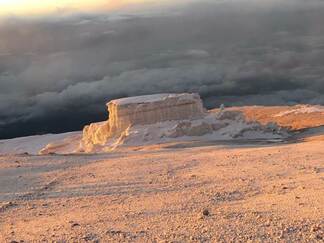 Shrinking ice fields, Mount Kilimanjaro Shrinking ice fields, Mount Kilimanjaro The following is a reflection written by Paul Smith’s College President Cathy Dove on her recent trip to Tanzania and Mount Kilimanjaro. As President of Paul Smith’s College, I have both a personal and professional interest in addressing issues dealing with the future of our planet and its inhabitants. Through the great work of the faculty and students, our college is committed to addressing climate change through education and research. One prime example of this is Paul Smith’s Climb it 4 Climate initiative, led by Bethany Garretson. This initiative is designed to raise money for student scholarships while promoting awareness of climate change issues. The more I learned about Climb it 4 Climate, it became clear that I had the unique opportunity to merge a long-standing goal of climbing one of the world’s highest peaks – Mt. Kilimanjaro – with providing support for this great initiative. Bethany was already planning to climb Aconcagua – the highest peak in South America and another of the seven summits of the world. My attempt to scale Kilimanjaro would complement her efforts. At 19,341 feet, Mt. Kilimanjaro is the highest peak in Africa. Due to its rapidly shrinking ice fields, it has been recognized as a very visible indicator of global climate change. Thus, on December 26, 2018 I began my trek up Kilimanjaro with 10 fellow climbers and over 60 guides and porters. For the next eight days we would hike through six ecological zones, beginning with a beautiful and lush rainforest and culminating in a frigid and barren Arctic zone. Along the way I had the opportunity to hear from several of the guides about how the mountain had changed since they had been leading trips. The guides were all men in their 30s who were born in the region and had been climbing the mountain for many years. In particular, the lead guide was a remarkable and thoughtful man who had been leading trips for almost ten years. He explained to me that while the rainfall in 2018 was good, for a number of years East Africa has been experiencing a lack of precipitation. So much of the Kilimanjaro region relies on the mountain – its once massive ice fields have provided abundant water to the region. These ice fields are now almost gone. Our guide estimated that in the short ten years he has been climbing Kilimanjaro they are at least 50% smaller. The troubling result is the towns and cities, with their heavy emphasis on agriculture, are struggling to maintain crop output. Dairy herds are dying. Due to increased temperatures, animals are moving up the mountain in search of food, and particularly in the Serengeti the animals are migrating further in search of water. Due to its long-standing abundance of water, the region’s infrastructure relies heavily on hydroelectric power; the lack of water has resulted in intermittent power in the towns and cities. There is widespread concern that the predicted lack of rainfall and imminent disappearance of the glaciers will result in a severe food and water shortage. Kilimanjaro guide Kibacha grew up in Moshi, Tanzania. Also, the significant tourism industry generated by Kilimanjaro adventurers would be severely threatened when the ice fields disappear. It is nearly impossible to carry sufficient water up to the highest altitudes to support the hikers; indeed currently some of the shrinking traditional water sources on the mountain have already resulted in challenges getting sufficient water up to the high altitude camps. While all of these issues are broadly acknowledged, there are no obvious long-term solutions, although individuals and the government are taking steps to anticipate dealing with further warming and lack of water, including storing food and water and regulating water utilization. These conversations with our remarkable guides were in my mind as we climbed further up the mountain. At daybreak on January 1, 2019 I reached the summit of Mt. Kilimanjaro. The bitter cold and wind did not detract from the incredible beauty and breathtaking views seen from the “Roof of Africa”. Sadly, the minimal icecaps were clear to see from the mountain peak. Those that remained were fragmented and one could almost see them cracking during the short time we were at the summit. As I descended (by far the worst part of the hike!), I reflected on the seriousness of the situation. While “Hakuna Matata” (Swahili for “no worries”) – is the Tanzanian outlook on life; it is clear that there is legitimate concern about the significant current and future impact of climate change. The Tanzanians, nor any country, can solve this problem in isolation. We each must join a unified, global community to raise awareness and create solutions. I’m proud that Paul Smith’s community is playing a leadership role in addressing one of the world’s greatest challenges.
1 Comment
6/9/2019 11:58:33 pm
Mt. Kilimanjaro reflects the Philippine situation of dead upland stream nets during summers. But there might be hope. All stream banks may be planted to sweet sorghum at 500 meter bands when rains come. Sorghum will resist dry weather thereafter because of their tangled roots that store moisture. Once established, tree saplings may come in, and iterations will create forests and year-round stream waters. The financing? Billion-dollar Climate Funds should persuade ethanol producers in USA, Brazil and India to set up small to medium-scale ethanol distilleries within the expansive sorghum farms in joint venture with local companies, co-ops and State agencies at 75% Fund financing. Gross profit can be higher than 50%, so the new farms and forests should perpetually exist, 'inhaling' CO2 and reducing dirty vehicle exhausts by 50% or so.
Reply
Leave a Reply. |
 RSS Feed
RSS Feed